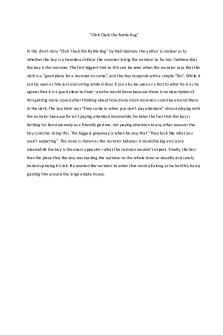2 articles: Summarizing \"The Boston Photographs\" and \"Don\'t Click\" PDF

| Title | 2 articles: Summarizing \"The Boston Photographs\" and \"Don\'t Click\" |
|---|---|
| Author | Sarah Rohrdanz |
| Course | Sophomore Seminar |
| Institution | Southern New Hampshire University |
| Pages | 3 |
| File Size | 66.6 KB |
| File Type | |
| Total Downloads | 83 |
| Total Views | 492 |
Summary
A required assignment summarizing two articles: "The Boston Photographs" and "Don't Click on Nude Photos, ISIS Videos" and connects the articles together...
Description
January 30, 2018 Professor Schulte Sophomore Seminar
In the article “The Boston Photographs,” Nora Ephron writes about the sensational photos taken of a woman and a child during a fire, from the Boston Herald American. The photos were taken as the firemen were attempting rescue—tragically, the woman and child fell before they could be saved. The woman died, the child did not. The photographs received a huge amount of feedback; some positive, but overwhelmingly negative. One of the arguments against the photo were that newspapers do not print photos of dead bodies. Why, therefore, is it okay to print a photo of a woman a split second before she died? Another was that newspapers do not print inappropriate images—why isn’t the moment before a woman’s death, in her last moment of panicked life, inappropriate to showcase? At the end of the article, Ephron says: “Why not print them?... That they disturb readers is exactly as it should be: that’s why photojournalism is often more powerful than written journalism.” (Ephron, n.d.) In Sally Kohn’s article, “Don’t Click on Celebrity Nude Photos, ISIS Videos,” the author explains how clicking on articles makes the reader partially responsible for the articles in the first place. If there was no audience, there would be no article. One example the author gives is a leak of celebrity nude photos, obtained by some hackers. The first leak gained so much popularity that some hackers leaked even more celebrity nudes. The ISIS videos spoken about in the article showed beheadings, and many news organizations struggled with whether or not to show violent videos and photos, and if so, how much. Kohn sums up her point in the middle of the article: “Let that sink in for a moment: ISIS wants you to watch those videos. The hackers who stole the celebrity pictures want you to look at them. When you click, you’re doing precisely what the bad guys want you to do.”
The articles were from completely separate sources, but have a similar theme to them. The first addressed the problem of what the media should or should not show, which was similarly addressed in Kohn’s article when she mentioned the ISIS videos. Ephron wrote, why not show the pictures? Photojournalism is more effective when it disturbs the readers. Along the same lines, Kohn wonders if the American and British outrage would have been as strong if the media had kept the ISIS videos from the public and simply wrote about the beheadings. Disturbing photos can be very moving, but how disturbing can they be before it’s inappropriate to print in the media?
ClassNora Ephron’s idea is that photojournalism is important, pictures need to be printed because the public has a right to know Sally Kohn argues that sensational pictures, pictures of violence/objectivity of individuals should not be viewed because the viewer becomes part of the problem How are they linked? What is the main theme? The public has a right to know of important events going on. The public also holds the power to steer what is published. People need to see photos and videos of events to be moved by them. The motivation behind the article or photos/videos is the most important thing.
References Ephron, N. (N.d.) The Boston Photographs. Kohn, S. (2014, Sep. 26). Don’t Click on Celebrity Nude Photos, ISIS Videos. Retrieved from CNN.com...
Similar Free PDFs

Click Clack the Rattle Bag
- 1 Pages

Locating and Summarizing Rules
- 4 Pages

Oil and Vinegar Dont Mix
- 8 Pages

Mr boston
- 340 Pages

4-3 Summarizing Assignment
- 1 Pages

the articles of English class
- 2 Pages

4-3 Assignment-Summarizing
- 2 Pages

Appel i boston modellen
- 2 Pages

3930 Click- Tert-butanol
- 8 Pages
Popular Institutions
- Tinajero National High School - Annex
- Politeknik Caltex Riau
- Yokohama City University
- SGT University
- University of Al-Qadisiyah
- Divine Word College of Vigan
- Techniek College Rotterdam
- Universidade de Santiago
- Universiti Teknologi MARA Cawangan Johor Kampus Pasir Gudang
- Poltekkes Kemenkes Yogyakarta
- Baguio City National High School
- Colegio san marcos
- preparatoria uno
- Centro de Bachillerato Tecnológico Industrial y de Servicios No. 107
- Dalian Maritime University
- Quang Trung Secondary School
- Colegio Tecnológico en Informática
- Corporación Regional de Educación Superior
- Grupo CEDVA
- Dar Al Uloom University
- Centro de Estudios Preuniversitarios de la Universidad Nacional de Ingeniería
- 上智大学
- Aakash International School, Nuna Majara
- San Felipe Neri Catholic School
- Kang Chiao International School - New Taipei City
- Misamis Occidental National High School
- Institución Educativa Escuela Normal Juan Ladrilleros
- Kolehiyo ng Pantukan
- Batanes State College
- Instituto Continental
- Sekolah Menengah Kejuruan Kesehatan Kaltara (Tarakan)
- Colegio de La Inmaculada Concepcion - Cebu






